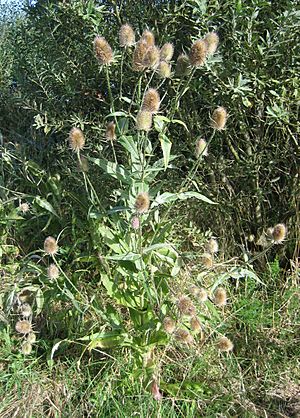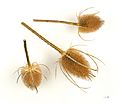Teasel facts for kids
Quick facts for kids Teasel |
|
|---|---|
 |
|
| Dipsacus fullonum | |
| Scientific classification | |
| Kingdom: | |
| (unranked): | |
| (unranked): | |
| (unranked): | |
| Order: | |
| Family: | |
| Genus: |
Dipsacus
|
| Species | |
|
See text. |
|
Teasel is a unique plant that belongs to the group called Dipsacus. There are about 15 different kinds, or species, of teasel plants. These flowering plants are usually tall and have lots of leaves. They are known as biennial plants, which means they live for two years.
Teasel plants originally come from Europe, Asia, and northern Africa. They can grow quite tall, reaching between 1 and 2.5 meters (about 3 to 8 feet) high. Their stems and leaves are often prickly.
The flowers of the teasel plant are usually purple, dark pink, or lavender. They grow right at the top of the stem. After the flowers bloom, the plant's head dries out. This dried head then holds many small seeds. These seeds are a very important food source for birds during the winter, especially for the European Goldfinch. Because of this, teasels are sometimes planted in gardens and nature reserves to help attract these beautiful birds.
In the United States, teasel is considered an invasive species. This means it's not originally from there. It can spread quickly and take over areas where native plants usually grow.
Types of Teasel Plants
There are many different kinds of teasel plants. Here are some of the most common ones you might hear about:
- Dipsacus ferox - This one is often called Spiny Teasel.
- Dipsacus fullonum - You might know this as Wild Teasel, Common Teasel, or Fuller's Teasel.
- Dipsacus japonica - This is the Japanese Teasel or Chinese Teasel.
- Dipsacus laciniatus - This type is known as Cut-leaved Teasel.
- Dipsacus pilosus - This is the Small Teasel.
- Dipsacus sativus - This is a special kind of Fuller's Teasel that people grow on purpose.
- Dipsacus strigosus - This one is called Slim Teasel.
- Teasel flowers
Images for kids
See also
 In Spanish: Dipsacus para niños
In Spanish: Dipsacus para niños










